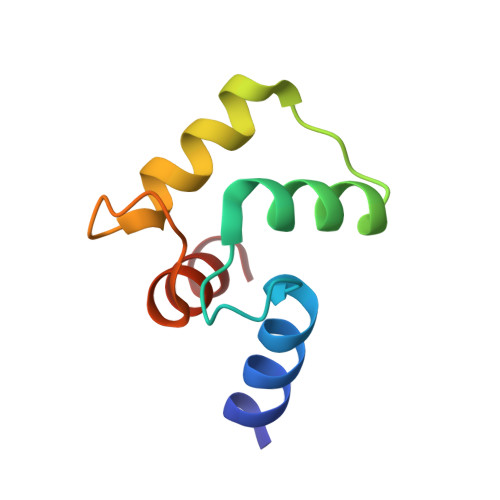The solution structures of two soybean calmodulin isoforms provide a structural basis for their selective target activation properties
Ishida, H., Huang, H., Yamniuk, A.P., Takaya, Y., Vogel, H.J.(2008) J Biol Chem 283: 14619-14628
- PubMed: 18347016
- DOI: https://doi.org/10.1074/jbc.M801398200
- Primary Citation of Related Structures:
2RO8, 2RO9, 2ROA, 2ROB - PubMed Abstract:
The intracellular calcium ion is one of the most important secondary messengers in eukaryotic cells. Ca(2+) signals are translated into physiological responses by EF-hand calcium-binding proteins such as calmodulin (CaM). Multiple CaM isoforms occur in plant cells, whereas only a single CaM protein is found in animals. Soybean CaM isoform 1 (sCaM1) shares 90% amino acid sequence identity with animal CaM (aCaM), whereas sCaM4 is only 78% identical. These two sCaM isoforms have distinct target-enzyme activation properties and physiological functions. sCaM4 is highly expressed during the self-defense reaction of the plant and activates the enzyme nitric-oxide synthase (NOS), whereas sCaM1 is incapable of activating NOS. The mechanism of selective target activation by plant CaM isoforms is poorly understood. We have determined high resolution NMR solution structures of Ca(2+)-sCaM1 and -sCaM4. These were compared with previously determined Ca(2+)-aCaM structures. For the N-lobe of the protein, the solution structures of Ca(2+)-sCaM1, -sCaM4, and -aCaM all closely resemble each other. However, despite the high sequence identity with aCaM, the C-lobe of Ca(2+)-sCaM1 has a more open conformation and consequently a larger hydrophobic target-protein binding pocket than Ca(2+)-aCaM or -sCaM4, the presence of which was further confirmed through biophysical measurements. The single Val-144 --> Met substitution in the C-lobe of Ca(2+)-sCaM1, which restores its ability to activate NOS, alters the structure of the C-lobe to a more closed conformation resembling Ca(2+)-aCaM and -sCaM4. The relationships between the structural differences in the two Ca(2+)-sCaM isoforms and their selective target activation properties are discussed.
Organizational Affiliation:
Structural Biology Research Group, Department of Biological Sciences, University of Calgary, Calgary, AB, Canada.















